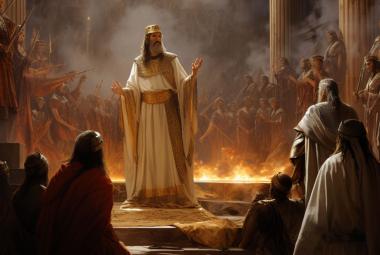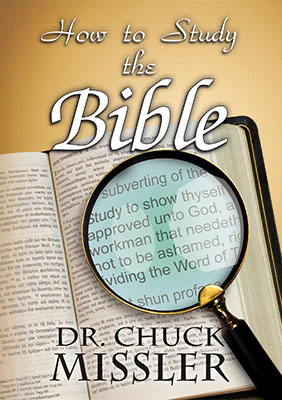My early zeal for studying the Scripture was dampened many years ago as I encountered what is often called "textual criticism." I was surprised to learn that it was naive and unlearned to regard the Book of Isaiah as actually written by the prophet Isaiah, as was commonly thought.
With its 66 chapters, Isaiah is the longest prophetic book of the Old Testament. Most scholars agree that the book falls naturally into two major sections, Chapters 1-39 and Chapters 40-66.
The first section has a distinctive style which changes noticeably in the final section. It is easy to remember since it parallels the Bible itself, with 39 books in the Old Testament and 27 in the New Testament. (But don't make too much of this; the chapter divisions, as we know them, were added in the 13th century.)
The Deutero-Isaiah Theory
The "textual critics" have insisted that the Book of Isaiah is a compilation of two different writers, each calling himself Isaiah but writing at different times. This "Deutero-Isaiah" theory is surprisingly prevalent in many modern ("liberal") commentaries. (There are some that even advocate a three-Isaiah theory.)
The first section of the book deals with God's approaching judgment on the nation of Judah. In some of the most striking passages in all the Bible, the prophet announces that God will punish His people because of their sin, rebellion, and worship of false gods. While this section includes many references to the coming Messiah, including His virgin birth1 and his rule on the throne of David,2 the style of this section is distinctive and certainly fits the subject matter.
The last section, in contrast to the first, is noticeably different. It emphasizes the Messianic expectation and an ultimate comfort for God's people. (Most of Handel's Messiah was drawn from this section of the Book of Isaiah.) The heart of his stunning prophecy occurs in Chapter 53, as Isaiah presents the role of the coming Messiah in its highest point. Some call this passage the "Holy of Holies" of the Old Testament. The Servant's suffering and death and the redemptive nature of His mission are clearly foretold. Although mankind deserved God's judgment because "we have turned, every one, to his own way,"3 God sent His Servant to take away our sins. According to Isaiah, it is through His suffering that we are reconciled with God, since "the Lord has laid on Him the iniquity of us all."
It is principally on the basis of the stylistic changes between the two sections that critics have developed the Deutero-Isaiah theory. Those who assign Chapters 40-66 to a "Second Isaiah" point out that the two major sections of the book seem to be set in different times. Chapters 1-39 clearly belong to the eighth century b.c., a turbulent period in the history of Judah.
But Isaiah 40-66, according to these scholars, seems to be addressed to the citizens of Judah who were being held as captives in Babylon about two centuries after Isaiah lived and prophesied. These scholars also point to the differences in tone, language, and style between the two major sections as proof that the book was written by two different authors.
The Traditional View
There are, however, conservative scholars who insist the entire book was written by the famous prophet Isaiah who ministered in the southern kingdom of Judah for 40 years, from about 740-700 b.c. They point out that the two sections of the book have many similarities, although they are dramatically different in tone and theme. Many phrases and ideas that are peculiar to Isaiah appear in both sections of the book.
A good example of this is Isaiah's unique reference to God as "the Holy One of Israel."4 The appearance of these words and phrases can be used to argue just as convincingly that the book was written by a single author.
In the second section of his book, Isaiah looked into the future and predicted the years of the Captivity and the return of the Covenant People to their homeland after the Captivity ended. If the prophet could predict the coming of the Messiah over 700 years before that happened, he could certainly foresee this major event in the future of the nation of Judah.
The style of each section deliberately matches its subject matter.
The Valley of Doubt
Doubts about the authorship and authenticity of any book in the Bible can have tragic consequences for those who are attempting to take the Bible seriously. As I look back on my own spiritual journey, I recall the many years that these views introduced a subtle doubt in my mind and hampered my real growth in the Word.
Is there a way to resolve this without getting drawn into the distressing debates and arrogant displays among erudite scholars and "textual critics"? Indeed, there is. I only wish I had discovered it earlier in my own travels through God's wondrous Word.
The Discovery in John 12
What a precious chapter! It has many marvelous insights, but among the dearest to me personally are verses 37-41:
37] But though he had done so many miracles before them, yet they believed not on him:
38] That the saying of Isaiah the prophet might be fulfilled, which he spake, Lord, who hath believed our report? and to whom hath the arm of the Lord been revealed?
39] Therefore they could not believe, because that Isaiah said again,
40] He hath blinded their eyes, and hardened their heart; that they should not see with their eyes, nor understand with their heart, and be converted, and I should heal them.
41] These things said Isaiah, when he saw his glory, and spake of him.
In this passage we first encounter a quote, in verse 38, familiar to many of you, that begins the famous chapter of Isaiah 53. This would be in the section attributed to the "Second Isaiah."
In verse 40 we have a quote from Isaiah Chapter 6 (v. 10), as verse 41 also highlights what occurs when Isaiah beholds the throne of God. This is, of course, in the first section of Isaiah.
Oh, how I am grateful for verse 39! Notice that John tells us that "that Isaiah said again" when he links the two passages and, thus, the two sections and attributes them both to "that" (same) Isaiah!
If you take John seriously, and recognize the inspiration of the Holy Spirit, then you need not doubt the authorship of Isaiah - both "sections."
It is fascinating to me to notice that there is no heresy - or controversy - that hasn't been anticipated by the Holy Spirit within the Scripture itself. If we recognize the reality that we have 66 books penned by 40 authors over thousands of years that are an integrated whole, and that every detail has been the result of careful and skillful engineering, then there is no need to stumble over the erudite skepticism and arrogance by scholarship falsely so called.
Isn't God wonderful? If we would just learn to take Him at His Word.
For a discussion of these and other "pitfalls" in studying God's Word, see our Briefing Package, How To Study The Bible.
Notes:
- Isaiah 7:14.
- Ibid. 9:6.
- Ibid. 53:6.
- Ibid. 1:4; 17:7; 37:23; 45:11; 55:5; 60:14.







